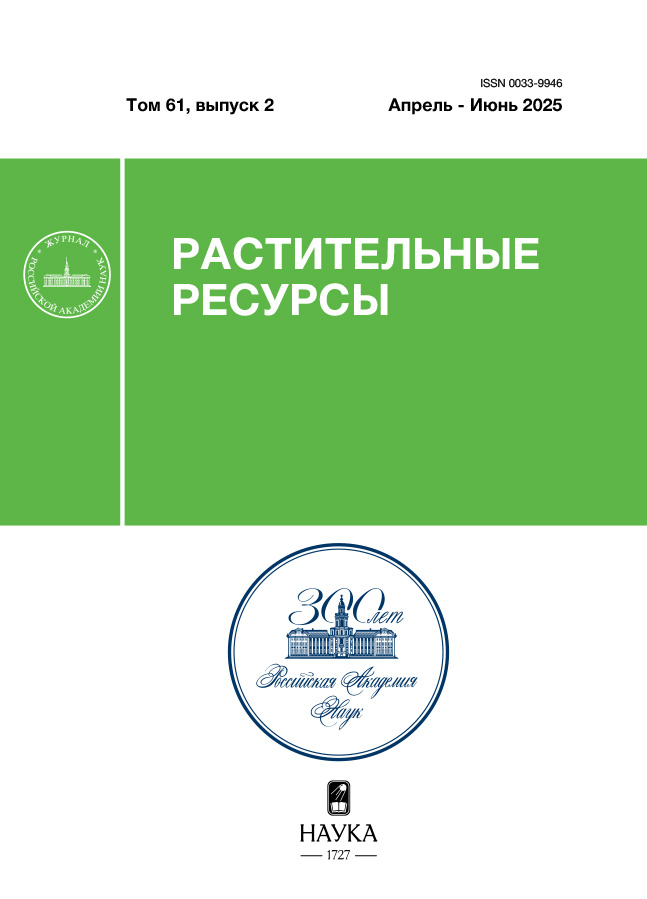Ontogenesis, ontogenetic structure and assessment of the state of Melilotus albus (Fabaceae) cenopopulations of in Central Yakutia
- Авторлар: Semenova V.V.1, Danilova N.S.1
-
Мекемелер:
- Institute of Biological Problems of Cryolithozone SB RAS
- Шығарылым: Том 61, № 2 (2025)
- Беттер: 109-121
- Бөлім: Structure of Plant Populations
- URL: https://cijournal.ru/0033-9946/article/view/687263
- DOI: https://doi.org/10.31857/S0033994625020084
- EDN: https://elibrary.ru/FZDETQ
- ID: 687263
Дәйексөз келтіру
Аннотация
Melilotus albus Medic. (Fabaceae) – annual/biennial plant with elongated shoots. In Central Yakutia, in the ontogeny of M. albus, 6 ontogenetic states have been identified: se – seeds, p – seedlings, j – juvenile, im – immature, v – virginal, g – generative. M. albus is renewed only by seed. M. albus is a species alien to Yakutia, where it was introduced at the beginning of the 20th century, and is found in the central and southern parts of the republic. All studied cenopopulations are normal and incomplete. The M. albus density is mainly affected by the humidity of the habitat. In moist areas, plants of M. albus quickly gain weight and suppress the growth and reproduction of other species. With low anthropogenic load, heavy precipitation in June causes rapid germination of honey clover, and by mid-summer – the development of groups of immature individuals. The predominance of the generative individuals in ontogenetic spectra can be observed in the absence or under low anthropogenic load and sufficient moisture (near water bodies, during irrigation). High anthropogenic load (grazing, mowing) increases the proportion of virginal individuals. With sufficient moisture under the forest canopy, the proportion of the juvenile individuals increases. M. albus displays itself as a flexible species – drought-resistant, shade-tolerant, resistant to soil compaction and trampling, as well as mechanical damage. Due to the accumulation of coumarins in the generative phase of development, adult M. albus are not consumed by horses, but suffer mechanical damage. Therefore, horse grazing is not a limiting factor for the development of M. albus. The total score assessment of M. albus cenopopulations showed that the habitat moisture and the absence of anthropogenic load are the main success factors for growth and development of the species. Regular annual mowing of M. albus causes a decrease in individual biometric indicators even with sufficient moisture in the habitat.
Негізгі сөздер
Толық мәтін
Авторлар туралы
V. Semenova
Institute of Biological Problems of Cryolithozone SB RAS
Хат алмасуға жауапты Автор.
Email: vvsemenova-8@yandex.ru
Ресей, Yakutsk
N. Danilova
Institute of Biological Problems of Cryolithozone SB RAS
Email: vvsemenova-8@yandex.ru
Ресей, Yakutsk
Әдебиет тізімі
- Conspectus florae Rossiae Asiaticae: Plantae vasculares. 2012. Novosibirsk. 640 p. (In Russian)
- [The Complete Encyclopedia of Russian agriculture and related sciences. Encyclopedia]. 1900. Vol. 3. St. Petersburg. 1284 p. (In Russian)
- Talovina G. V., Smekalova T. N. 2021. Genus Melilotus in the flora of Russia and adjacent countries. — Vavilovia. 4(4): 3–27. https://doi.org/10.30901/2658-3860-2021-4-3-27 (In Russian)
- Suvorov V. V. 1950. [Melilotus (Tourn.) Adans. Em.]. — In: [Cultural flora of the USSR]. XIII(1): 345–500. (In Russian)
- Andrusova G. M. 2005. [Breeding evaluation of the honey clover samples in Eastern Transbaikalia: Dis. Cand. (Agricultural) Sci.]. Tyumen. 151 p. (In Russian)
- Yakovlev A. S. 1968. [Honey clover (Melilotus Mill.) in the Yakutian ASSR: Abst … Dis. Cand. (Agricultural) Sci.]. Leningrad. 25 p. (In Russian)
- Komarov V. L. 1926. [Introduction to the study of vegetation of Yakutia]. — [Proceedings of the Commission for the Studies of the Yakutian ASSR]. Leningrad. Vol. 1. 168 p. (In Russian)
- Usanova V. M., Perfilyeva V. I. 1966. [Determinant of fodder plants of the Yakutia]. Moscow; Leningrad. 118 p. (In Russian)
- [Plant resources of Russia: Wild flowering plants, their component composition and biological activity. Family Fabaceae–Apiaceae]. 2010. Vol. 3. St. Petersburg; Moscow. 601 p. (In Russian)
- [Biologically active plants and fungi of Siberia in clinical medicine]. 2019. Vol. 1. Moscow. 382 p. https://www.elibrary.ru/pckisj (In Russian)
- Androsova D. N. 2020. [Ecological and biological features of the seed germination of herbaceous plants from the natural flora of Central Yakutia under introduction: Dis. Cand. (Biology) Sci.]. Yakutsk. 181 p. (In Russian)
- Korchagin A. A. 1964. [Species composition of plant communities and methods of its study]. — In: [Field geobotany]. 3. Moscow: 39–62. (In Russian)
- Troeva E. I., Zverev A. A., Koroljuk A. Yu., Cherosov M. M. 2010. [Ecological scales of flora and mycobiota of Yakutia]. — In: [Flora of Yakutia: Geographical and environmental aspects]. Novosibirsk. P. 114–150. (In Russian)
- Markov M. V. 1992. [Structure and population biology of young plants of the central part of the Russian Plain: Abstr. … Dis. Doct. (Biology) Sci.]. Moscow. 34 p. (In Russian)
- Rabotnov T. A. 1950. [The life cycle of perennial herbaceous plants in meadow cenoses]. — Tr. BIN AN SSSR. Ser. 3, Geobotanika. 6: 7–197. (In Russian)
- Serebryakov I. G. 1952. [Morphology of vegetative organs of higher plants]. Moscow. 392 p. (In Russian)
- Zhukova L. A., Shestakova E. V., Semenova Yu. Yu. 2007. [Ontogenesis of yellow sweet clover (Melilotus officinalis (L.) Pall.)]. — In: [Ontogenetic atlas of plants]. Yoshkar-Ola. Vol. 5. P. 96–100. https://istina.ips.ac.ru/publications/book/19901577/ (In Russian)
- Uranov A. A. 1967. [Ontogenesis and age composition of populations] – In: [Ontogenesis and age composition of flowering plant populations]. Moscow. P. 3–8. (In Russian)
- Uranov A. A. 1975. [The age spectrum of cenopopulations as a function of time and energy wave processes]. — Nauchnye Doklady Vysshey Shkoly. Biologicheskie Nauki. 2: 7–34. (In Russian)
- [Plant cenopopulations (Basic concepts and structure)]. 1976. Moscow. 217 p. (In Russian)
- Zhivotovsky L. A. 2001. Ontogenetic states, effective density, and classification of plant populations. — Russ. J. Ecol. 32(1): 1–5. https://doi.org/10.1023/A:1009536128912
- Zaugolnova L. B. 1994. [Structure of seed plant populations and problems of their monitoring: Abstr. … Dis. Doct. (Biology) Sci.]. St. Petersburg. 70 p. (In Russian)
Қосымша файлдар












